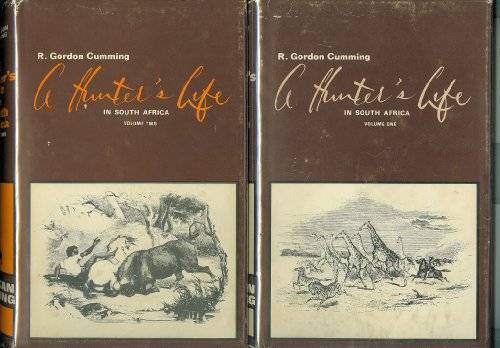
A Hunter's Life in South Africa - two volumes (new)
Check my rate
| Main centres: | 1-3 business days |
| Regional areas: | 3-4 business days |
| Remote areas: | 3-5 business days |

| Main centres: | 1-3 business days |
| Regional areas: | 3-4 business days |
| Remote areas: | 3-5 business days |
Books of Zimbabwe, Bulawayo, ZW, 1980, African Hunting Reprint series, facsimile reproduction of the 1850 edition with a new frontispiece and introduction, hardcovers, two volumes, complete, illustrated, condition: as new.
The author, R.Gordon Cumming, hunted up to the Zambezi River, indulging himself in the sport to an extent almost unique even among the mighty hunters of Africa.
Roualeyn George Gordon-Cumming (1820 1866) was a Scottish traveler and sportsman, known as the "lion hunter
From his early years he was distinguished by his passion for sport. He was educated at Eton, England, and at eighteen joined the East India Company's service as a cornet in the Madras Light Cavalry.
During his stay in the East he had laid the foundation of his collection of hunting trophies and specimens of natural history. In 1843 he joined the Cape Mounted Rifles, but for the sake of absolute freedom sold out at the end of the year and with an ox wagon and a few native followers set out for the interior of Africa. He hunted chiefly in Bechuanaland and the valley of the Limpopo River, regions then swarming with big game. David Livingstone, who furnished Gordon-Cumming with most of his native guides, wrote: I have no hesitation in saying that Mr. Cumming's book conveys a truthful idea of South African hunting.
Livingstone in general considered Gordon-Cumming as "a mad sort of Scotchman" who caused him difficulties. When Gordon-Cumming's oxen succumbed to Animal African trypanosomiasis Livingstone was obliged to change his plans and send all his own oxen to extricate the hunter and his entourage. Worse still, when Gordon-Cumming supplied Setshele, the ruler of the Kwêna people of Botswana, with guns in exchange for ivory, it was Livingstone who was blamed for arming the Africans.
Gordon-Cumming's collection of hunting trophies was exhibited in London in 1851 at the Great Exhibition, and was illustrated by a lecture he delivered. The collection, known as The South Africa Museum, was afterwards exhibited in various parts of the United Kingdom. In 1858 Gordon-Cumming went to live at Fort Augustus, Scotland, on the Caledonian Canal, where the exhibition of his trophies attracted many visitors. He died there in 1866.